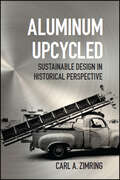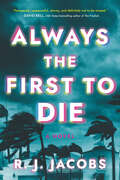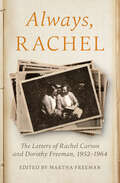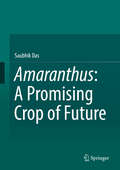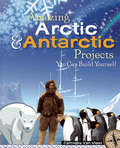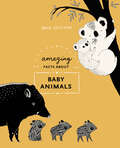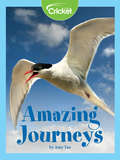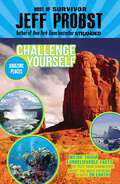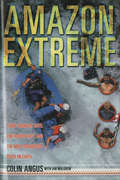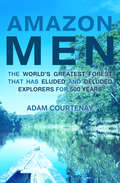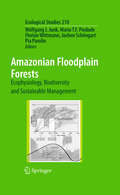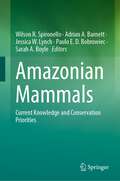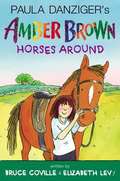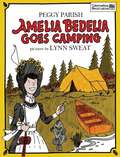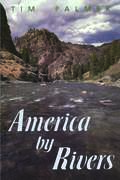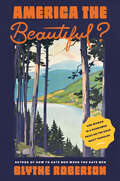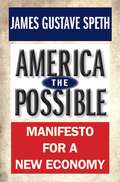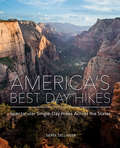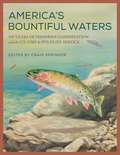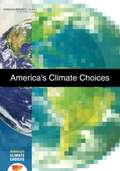- Table View
- List View
Aluminum Upcycled: Sustainable Design in Historical Perspective (Johns Hopkins Studies in the History of Technology)
by Carl A. ZimringTracing the benefits—and limitations—of repurposing aluminum.Besides being the right thing to do for Mother Earth, recycling can also make money—particularly when it comes to upcycling, a zero waste practice where discarded materials are fashioned into goods of greater economic or cultural value. In Upcycling Aluminum, Carl A. Zimring explores how the metal’s abundance after World War II—coupled with the significant economic and environmental costs of smelting it from bauxite ore—led to the industrial production of valuable durable goods from salvaged aluminum. Beginning in 1886 with the discovery of how to mass produce aluminum, the book examines the essential part the metal played in early aviation and the world wars, as well as the troubling expansion of aluminum as a material of mass disposal. Recognizing that scrap aluminum was as good as virgin material and much more affordable than newly engineered metal, designers in the postwar era used aluminum to manufacture highly prized artifacts. Zimring takes us on a tour of post-1940s design, examining the use of aluminum in cars, trucks, airplanes, furniture, and musical instruments from 1945 to 2015. By viewing upcycling through the lens of one material, Zimring deepens our understanding of the history of recycling in industrial society. He also provides a historical perspective on contemporary sustainable design practices. Along the way, he challenges common assumptions about upcycling’s merits and adds a new dimension to recycling as a form of environmental absolution for the waste-related sins of the modern world. Raising fascinating questions of consumption, environment, and desire, Upcycling Aluminum is for anyone interested in industrial and environmental history, discard studies, engineering, product design, music history, or antiques.
Always the First to Die: A Novel
by R.J. Jacobs"R. J. Jacobs is a masterful storyteller. A must read." —Alex Finlay, author of The Night Shift and Every Last FearFor fans of Riley Sager with a classic slasher twist comes a chilling thriller following a former horror movie actress who returns to the set of her most famous film…and is soon entangled in a series of terrifying events that resemble the plot of that one cursed movie.For Lexi, the Pinecrest Estate has become a place of horror. The dilapidated manor house in the Florida Keys, once the site of her teenage movie debut, is now haunted by memories. Memories of working on a legendary horror director's most famous film and of the terrible death that propelled them all to infamy. And ever since Lexi fled the Keys, she has vowed to never return.Until, years later, her daughter escapes to the Pinecrest in search of answers. Right when a Category 4 hurricane hits the southern coast.Now, Lexi is back on the ravaged island with only a few remaining behind, and soon enough, her life begins to resemble the plot of her most famous film. And this time, she's not sure who will make it out alive."An utterly unique thriller that combines horror movies, hurricanes, and deadly secrets from the past...definitely not to be missed"—David Bell, USA Today bestselling author of The Finalists
Always, Rachel: The Letters of Rachel Carson and Dorothy Freeman, 1952–1964
by Rachel Carson Dorothy E. FreemanThese letters between the pioneering environmentalist and her beloved friend reveal &“a vibrant, caring woman behind the scientist&” (Los Angeles Times). &“Rachel Carson, author of The Silent Spring, has been celebrated as the pioneer of the modern environmental movement. Although she wrote no autobiography, she did leave letters, and those she exchanged—sometimes daily—with Dorothy Freeman, some 750 of which are collected here, are perhaps more satisfying than an account of her own life. In 1953, Carson became Freeman's summer neighbor on Southport Island, ME. The two discovered a shared love for the natural world—their descriptions of the arrival of spring or the song of a hermit thrush are lyrical—but their friendship quickly blossomed, as each realized she had found in the other a kindred spirit. To read this collection is like eavesdropping on an extended conversation that mixes the mundane events of the two women's family lives with details of Carson&’s research and writing and, later, her breast cancer. . . . Few who read these letters will forget these remarkable women and their even more remarkable bond.&” —Publishers Weekly &“Darting, fresh, sensuous, pleasingly elliptical at times, these letters also serve to tether the increasingly deified Carson firmly to earth—just where she&’d want to be.&” —Kirkus Reviews (starred review) &“It is not often that a collection of letters reveals character, emotional depth, personality, indeed intellect and talent, as well as a full biography might; these letters do all that.&” —The New York Times Book Review &“Provides insight into the creative process and a look into the daily lives of two intelligent, perceptive women whose family responsibilities were, at times, almost crushing.&” —Library Journal &“Dotted with vivid observations of the natural world and perceptive commentary on friendship, family, fame, and life itself, Always, Rachel will appeal to readers interested in biography and women&’s studies as well as those drawn to nature writing and the history of the environmental movement.&” —Booklist Online
Amaranthus: A Promising Crop of Future
by Saubhik DasThis book serves the larger community of plant researchers working on the taxonomy, species delimitation, phylogeny, and biogeography of pseudo-cereals, with a special emphasis on amaranths. It also provides extensive information on the nutritive value of underutilized pseudo-cereals, the goal being to broaden the vegetable list. Amaranthus is a cosmopolitan genus of annual or short-lived perennial plants. Most of the species are summer annual weeds and are commonly referred to as pigweed. Only a few are cultivated as vitamin-rich vegetables and ornamentals. The protein-rich seeds of a handful of species, known as grain amaranths, are consumed as pseudo-cereals. Amaranthusmanifests considerable morphological diversity among and even within certain species, and there is no general agreement on the taxonomy or number of species. Currently the genus Amaranthus is believed to include three recognized subgenera and 70 species. Amatanthus is considered to potentially offer an alternative crop in temperate and tropical climate. The classification of amaranths is ambiguous due to the lack of discrete and quantitative species-defining characteristics and the wide range of phenotypic plasticity, as well as introgression and hybridization involving weedy and crop species. It is a known fact that both vegetable and grain amaranths have evolved from their respective weed progenitors. There are more than 180 different weed species that are herbicide-resistant, and amaranths are considered to be leading members of the resistant biotypes. Amaranth species provide ample scope for investigating herbicide resistance mechanisms. Amaranths also show variability in terms of their mating behavior and germplasm, adaptability to different growing conditions, and wide range of variability in sexual systems, from monoecy to dioecy. A solid grasp of these parameters is essential to the future utilization of amaranths as super crops. There are quite a few amaranth research center and germplasm collections all over the world that maintain and evaluate working germplasms. To date, the genetic improvement of amaranths has primarily involved the application of conventional selection methods. But advances in genomics and biotechnology have dramatically enriched the potential to manipulate the amaranth genome, especially improving the amount and availability of nutrients. In conclusion, the book covers all aspects of amaranths, including their food value, significance as vegetables and pseudo-cereals, taxonomy, phylogeny, germplasm variability, breeding behavior and strategies, cultivation practices, and variability in terms of their sexual systems. It offers a valuable resource for all students, researchers and experts working in the field of plant taxonomy and diversity.
Amazing Arctic and Antarctic Projects
by Steven Weinberg Carmella Van VleetAmazing Arctic & Antarctic Projects You Can Build Yourself explores the Earth's polar regions with 25 interactive projects, activities, and experiments. Kids ages 9 and up will discover that the coldest places on Earth hold fascinating scientific wonders and mysteries. Historical facts and anecdotes, biographies, and fascinating trivia support the fun projects to teach young readers about the harsh polar climate, immense Arctic tundra, magical Northern Lights, vast glaciers, ancient frozen lakes, remarkable animals and plants, brave explorers, innovative people who live and work at the top and bottom of the world, and the vital importance of conservation. With Amazing Arctic & Antarctic Projects You Can Build Yourself kids will gain an appreciation for the exciting and extraordinary polar environments.
Amazing But True Fishing Stories
by Allan Zullo Bruce NashA school of fish raining from the sky . . . anglers catching eighty-three sailfish in one day-fish tales? No, Amazing but True Fishing Stories. In the tradition of Nash and Zullo's Amazing but True Golf Facts and The Sports Hall of Shame book series comes a compendium of true tales, angling antics, and fish facts. This is a book that once again demonstrates how truth can be stranger than fiction. Consider: the Frenchman who caught 590 fish in one hour with a single pole; the angler who used his rod and reel to hook and save a drowning woman; the man who lost his thumb in a boating accident-and found it seven months later, in the belly of a trout! These and many more terrific tales, crazy catches, and daring duels can be found in Amazing but True Fishing Stories.
Amazing Facts About Baby Animals: An Illustrated Compendium
by Maja SäfströmA whimsically illustrated collection of fascinating, surprising, and funny facts about baby animals and their parents, from the author of The Illustrated Compendium of Amazing Animal Facts.Who doesn't love baby animals? Amazing Facts About Baby Animals is an adorable celebration of all kinds of fuzzy, fluffy, scaly, and feathery animal babies and their parents. This charming collection by beloved Swedish artist Maja Säfström is full of interesting, weird, and funny facts about animals before they are born (elephants are pregnant for 22 months!), when they are born (whales are born tail-first so they don't drown!), and life as babies (parrots give their offspring names! Baby macaques have snowball fights!). Perfect for art- and nature-loving kids and adults, this sweet book makes a wonderful gift and conversation starter for the whole family.
Amazing Journeys
by Amy TaoWhy do some animals migrate? In this story, readers will learn about the journeys of animals to find more food or to seek better weather. Six animals—a wildebeest, bat, tern, godwit, dragonfly, and penguin—describe what makes their migrations amazing.
Amazing Places: Weird trivia and unbelievable facts to test your knowledge about the most extreme places on earth! (Challenge Yourself #2)
by Jeff ProbstCHALLENGE YOURSELF! A new nature-based trivia series with vibrant visuals and fascinating facts! Discover the most incredible natural wonders and extreme places on earth! New from Emmy-Award winning host of Survivor and New York Times bestselling author of Stranded, Jeff Probst comes a dynamic and graphic line of trivia books! Packed with full-color photos, fascinating facts and trivia, and great callouts from Jeff, this series is perfect for every kid looking to know the coolest, weirdest facts and trivia around! Challenge yourself to discover the world&’s most extreme places! From the driest desert to the deepest ocean trench and everything in between, find out all the fascinating facts about the land, sea, and air.
Amazing Plant Bodies: Tiny To Gigantic (Into Reading, Read Aloud Module 9 #3)
by Ellen LawrenceNIMAC-sourced textbook <P><P>Most plants have roots, stems, and leaves. Many grow flowers, seeds, and fruits. Some plants, however, have developed spectacular examples of these plant parts! From the longest roots in the world to the biggest seeds, this fact-filled volume looks at the biggest, smallest, weirdest, and most unusual plant parts in the world! Filled with information perfectly suited to the abilities and interests of an early elementary audience, this colorful, fact-filled volume gives readers a chance not only to learn, but also to develop their powers of observation and critical thinking. From fascinating images to high-interest facts, this book makes learning about plant bodies a lively and engaging experience. Amazing Plant Bodies: Tiny to Gigantic is part of Bearport's Plant-ology series. <P><P>Lexile Measure: IG590L
Amazon Adventure: How Tiny Fish Are Saving the World's Largest Rainforest
by Sy Montgomery Keith Ellenbogen<P>Considered the “lungs of the world,” the Amazon provides a full fifth of the world’s oxygen, and every year unsustainable human practices destroy 2.7 million acres. What can be done to help? That’s where Project Piaba comes in. <P>Join the award-winning author Sy Montgomery and the photographer Keith Ellenbogen as they traverse the river and rainforest to discover how tiny fish, called piabas, can help preserve the Amazon, its animals, and the rich legacy of its people. Amazon Adventure is an eye-opening—and ultimately hopeful—exploration of how humanity’s practices are affecting and shaping not only the Amazon, but our entire environment. <P><B>Winner of the 2018 Riverby Award</b>
Amazon Extreme: Three Ordinary Guys, One Rubber Raft and the Most Dangerous River on Earth
by Colin Angus Ian MulgrewThe hair-raising true story of the first team to raft the entire length of the Amazon. To a trio of twenty-something adrenaline junkies, it sounded like an irresistible challenge: Tackle the Amazon with nothing more than a rubber raft between them and fate. In Amazon Extreme Colin Angus provides a you-are-there account of his expedition's terrors and triumphs. In spite of Shining Path gunmen, mosquito-laden drinking water, and, of course, the terrifying rapids themselves, his crew also found a reverence for the equally compelling beauty that makes this region so renowned. Graceful dolphins, lush forests, and the intriguing people who live along the river complete the backdrop as Angus's five-month excursion unfolds. Culminating in an astonishing victory that garnered major media coverage, this is the story of three guys who truly went off the deep end, and one who came back to write a riveting recollection of it.
Amazon Mazhaikkadukal
by S. MohanaThe Amazon Rainforest is a moist broadleaf forest that covers most of the Amazon Basin of South America and represents over half of the planet's remaining rainforests. This book enlightens the readers as to What is Amazon; Amazon River; The rainforest and how it was formed; the animals and other living beings in the region; the precious things found there; tourist spots and the impending dangers to the region etc.
Amazon Men: The World's Greatest Forest that Has Eluded and Deluded Explorers for 500 Years
by Adam Courtenay“Captivating . . . An examination of complex and contradictory human responses to the development of the Amazon and to its preservation” (The Australian). Amazon Men is about conquistadors and botanists, colonizers and human rights activists, slave traders and philanthropists—that is, people who have variously tried to conquer, rework, map, enslave, and save this region and its river system, each according to the needs and zeitgeist of their time in history. The environmental battles of today are part of a long-running story that’s been going on since Europeans first discovered this impenetrable ocean of green. For centuries there’s been a war of attrition between the greatest ecosystem and the greatest predator. Up until now, the predator has failed. Amazon Men is about those who’ve tried to conquer and exploit the Amazon—and those who’ve tried to understand and savor it. Conquistadors Francisco de Orellana and Lope de Aguirre play their parts as representatives of the Age of Discovery. Charles Marie de La Condamine is a perfect foil for the Age of Enlightenment. Alexander von Humboldt appears as a scientist of the Romantic age, seeking unity in the midst of chaos. Walter Hardenburg represents the machine age, defying the industrial imperatives of his time to oppose unfettered colonial capitalism. Sydney Possuelo, the greatest living Amazonian explorer, represents the ongoing conflict between modern expansion and environmental causes. What do their experiences tell us about our attitude to the unexplored and unknown? The stories of Amazon Men recount deeds of bravery and acts of brilliance, but also forgotten holocausts where guns, germs, and steel have all played their roles.
Amazonian Floodplain Forests: Ecophysiology, Biodiversity and Sustainable Management (Ecological Studies #210)
by Florian Wittmann Jochen Schöngart Maria T. Piedade Pia Parolin Wolfgang J. JunkCentral Amazonian floodplain forests are an unique and endangered ecosystem. The forests grow in areas that are annually flooded by large rivers during mean periods of up to 8 months and at depths of up to 10 m. Despite this severe stress, these forests consist of over 1,000 species and are by far the most species-rich floodplain forests worldwide. The trees show a broad range of morphological, anatomical, physiological, and phenological adaptations that enable them not only to survive the adverse environmental conditions, but also to produce large amounts of biomass when the nutrient levels in water and soils are sufficiently high. This is the case in the floodplains of white-water rivers, which are used for fisheries, agriculture, and cattle-ranching but which also have a high potential for the production of timber and non-timber products, when adequately managed. Latest research on ecophysiology gives insight how tree species adapt to the oscillating flood-pulse focusing on their photosynthesis, respiration, sap flow, biochemistry, phenology, wood and leave anatomy, root morphology and functioning, fruit chemistry, seed germination, seedling establishment, nitrogen fixation and genetic variability. Based on tree ages, lifetime growth rates and net primary production, new concepts are developed to improve the sustainability of traditional forest managements in the background of an integrated natural resource management. This is the first integrative book on the functioning and ecologically oriented use of floodplain forests in the tropics and sub-tropics.It provides fundamental knowledge for scientist, students, foresters and other professionals on their distribution, evolution and phytogeography. "This book is an excellent testimony to the interdisciplinary collaboration of a group of very dedicated scientists to unravel the functioning of the Amazonian Floodplain forests. They have brought together a highly valuable contribution on the distribution, ecology, primary production, ecophysiology, typology, biodiversity, and human use of these forests offering recommendations for sustainable management and future projects in science and development of these unique wetland ecosystems. It lays a solid scientific foundation for wetland ecologists, foresters, environmentalists, wetland managers, and all those interested in sustainable management in the tropics and subtropics." Brij Gopal, Executive Vice President International Society for Limnology (SIL).
Amazonian Mammals: Current Knowledge and Conservation Priorities
by Adrian A. Barnett Wilson R. Spironello Jessica W. Lynch Paulo E. D. Bobrowiec Sarah A. BoyleThe mammal fauna of the Brazilian Amazon is one of the most diverse on Earth with over 450 known species. Bringing together more than 70 of the world’s top experts on Amazonian mammals, this book unites, for the first time, up-to-date data on the current state of knowledge on the ecology of all groups of non-rodent mammals in the Brazilian Amazon, analyses the effectiveness of current conservation programmes and identifies research and conservation priorities for the future.
Amber Brown Horses Around (Amber Brown #12)
by Paula Danziger Bruce Coville Elizabeth Levy Anthony LewisThe most colorful chapter-book character is going to camp! <P><P> Amber Brown is one happy camper. She and her best friend, Justin, are spending the summer at Camp Cushetunk. Learning to ride Cinnamon, the sweetest horse ever, is so amazing that Amber doesn't even mind shoveling her poop. <P><P> Then Amber becomes the target of a series of pranks. Certain she knows who is behind them, Amber and her friends come up with the biggest prank ever to get revenge. But the outcome is not what they expect. <P><P> Turns out horsing around can lead to big trouble. But sometimes, Amber is surprised to learn, big trouble can lead to big changes for the better.
Amelia Bedelia Goes Camping (I Can Read! #9)
by Peggy ParishA literal-minded housekeeper causes a ruckus on a camping trip when she attempts to make sense of some instructions. Picture descriptions added.
America by Rivers
by Tim PalmerPhotographer and writer Tim Palmer has spent more than 25 years researching and experiencing life on the waterways of the American continent. He has travelled by canoe or raft on more than 300 different rivers, down wide placid streams and rough raging rapids. His journeys have taken him to every corner of the country, where he has witnessed and described the unique interaction of geographical, historical, and cultural forces that act upon our nation's vital arteries.America by Rivers represents the culmination of that grand adventure. Palmer describes the rivers of America in all their remaining glory and tarnished beauty, as he presents a comprehensive tour of the whole of America's river systems. Filled with important new information as well as data gathered from hundreds of published sources, America by Rivers covers: the network of American waterways and how they fit together to form river systems unique features of individual rivers along with their size, length, and biological importance environmental problems affecting the rivers of different regions and what is being done to protect and restore them cultural connections and conflicts surrounding the rivers of each region Chapters address the character of rivers in distinct regions of the country, and each chapter highlights one river with a detailed view from the water. Rivers profiled include the Penobscot, Potomac, Suwanee, Minnesota, Niobara, Salmon, Rio Grande, American, Rogue, and Sheenjek. Eighteen maps guide the reader across the country and 100 photos illustrate the splendor of Palmer's fascinating subject.America by Rivers provides a new way of seeing our country, one that embraces the entire landscape and offers fresh avenues to adventure. It is compelling reading for anyone concerned about the health of our land and the future of our waterways.
America the Beautiful?: One Woman in a Borrowed Prius on the Road Most Traveled
by Blythe RobersonThe author of How to Date Men When You Hate Men examines Americans’ obsession with freedom, travel, and the open road in this funny, entertaining travelogue that blends the humorous observations of Bill Bryson with the piercing cultural commentary of Jia Tolentino.For writer and comedian Blythe Roberson, there are only so many Mary Oliver poems you can read about being free, and only so many times you can listen to Joni Mitchell’s travel album Hejira, before you too, are itching to take off. Canonical American travel writers have long celebrated the road trip as the epitome of freedom. But why does it seem like all those canonical travel narratives are written by white men who have no problems, who only decide to go the desert to see what having problems feels like?To fill in the literary gaps and quench her own sense of adventure, Roberson quits her day job and sets off on a Great American Road Trip to visit America’s national parks.America the Beautiful? is a hilarious trip into the mind of one of the Millennial generation’s funniest writers. Borrowing her Midwestern stepfather’s Prius, she heads west to the Loop of mega-popular parks, over to the ocean and down the Pacific Coast Highway, and, in a feat of spectacularly bad timing, through the southwestern desert in the middle of July. Along the way she meets new friends on their own personal quests, learns to cope with abstinence while missing the comforts of home, and comes to understand the limits—and possibilities—of going to nature to prove to yourself and your Instagram followers that you are, in fact, free.The result is a laugh-out-loud-while-occasionally-raging-inside travelogue, filled with meditations and many, many jokes on ecotourism, conservation, freedom, traffic, climate change, and the structural and financial inequalities that limit so many Americans’ movement. Ultimately, Roberson ponders the question: Is quitting society and going on the road about enlightenment and liberty—or is it just selfish escapism?
America the Possible: Manifesto for a New Economy
by James Gustave SpethIn this third volume of his award-winning American Crisis series, James Gustave Speth makes his boldest and most ambitious contribution yet. He looks unsparingly at the sea of troubles in which the United States now finds itself, charts a course through the discouragement and despair commonly felt today, and envisions what he calls America the Possible, an attractive and plausible future that we can still realize. The book identifies a dozen features of the American political economy—the country's basic operating system—where transformative change is essential. It spells out the specific changes that are needed to move toward a new political economy—one in which the true priority is to sustain people and planet. Supported by a compelling "theory of change" that explains how system change can come to America, the book also presents a vision of political, social, and economic life in a renewed America. Speth envisions a future that will be well worth fighting for. In short, this is a book about the American future and the strong possibility that we yet have it in ourselves to use our freedom and our democracy in powerful ways to create something fine, a reborn America, for our children and grandchildren.
America's Best Day Hikes: Spectacular Single-day Hikes Across The States
by Derek Dellinger50 of the greatest hikes in the country, for all abilities and in all landscapes Beautifully illustrated, this best-of compendium features the most memorable one-day hikes in every region of the United States from Sierra Buttes Lookout in Tahoe National Forest to Grinnell Glacier Trail in Montana's Glacier National Park to Giant Mountain in Adirondack Park and beyond. Organized by region, this guide goes into detail about what makes each hike so remarkable and why it might be worth a detour or even a special journey for someone looking to broaden their horizons. All of the hikes are doable during daylight hours and none require camping. America’s Best Day Hikes comes with all the information anyone would need to experience these unique locations, including details about the hike itself—difficulty, duration, seasonal hazards, and more.—as well as traveling, planning, and packing suggestions. All this paired with Derek Dellinger’s stunning photography makes this incredible volume a must-have for any lover of the outdoors.
America's Bountiful Waters: 150 Years of Fisheries Conservation and the U.S. Fish & Wildlife Service
by National Fish National Fish and Aquatic Conservation ArchiveFish and Aquatic Conservation (FAC) in the U.S. Fish & Wildlife Service is the direct descendant of the U.S. Fish Commission, founded in 1871. In 2021, FAC marks its 150th anniversary, the oldest conservation agency in history. To commemorate this milestone, U.S. F&W will publish a compelling history to celebrate the broad-thinking scientists, writers, and artists who led us through the gilded age of American ichthyology into the present day.
America's Climate Choices
by Board on Atmospheric Sciences ClimateClimate change is occurring. It is very likely caused by the emission of greenhouse gases from human activities, and poses significant risks for a range of human and natural systems. And these emissions continue to increase, which will result in further change and greater risks. America's Climate Choices makes the case that the environmental, economic, and humanitarian risks posed by climate change indicate a pressing need for substantial action now to limit the magnitude of climate change and to prepare for adapting to its impacts. Although there is some uncertainty about future risk, acting now will reduce the risks posed by climate change and the pressure to make larger, more rapid, and potentially more expensive reductions later. Most actions taken to reduce vulnerability to climate change impacts are common sense investments that will offer protection against natural climate variations and extreme events. In addition, crucial investment decisions made now about equipment and infrastructure can "lock in" commitments to greenhouse gas emissions for decades to come. Finally, while it may be possible to scale back or reverse many responses to climate change, it is difficult or impossible to "undo" climate change, once manifested. Current efforts of local, state, and private-sector actors are important, but not likely to yield progress comparable to what could be achieved with the addition of strong federal policies that establish coherent national goals and incentives, and that promote strong U. S. engagement in international-level response efforts. The inherent complexities and uncertainties of climate change are best met by applying an iterative risk management framework and making efforts to significantly reduce greenhouse gas emissions; prepare for adapting to impacts; invest in scientific research, technology development, and information systems; and facilitate engagement between scientific and technical experts and the many types of stakeholders making America's climate choices.
